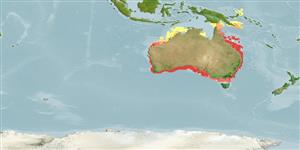Classification / Names
Common names from other countries
Main reference
Size / Weight / Age
Max length : 290 cm TL male/unsexed; (Ref. 6871)
Length at first maturity
Lm ?, range 94 - ? cm
Environment
Marine; reef-associated; depth range 0 - 100 m (Ref. 54689)
Climate / Range
Tropical, preferred ?; 1°N - 40°S, 114°E - 154°E
Distribution
Indo-Pacific: Indonesia, Papua New Guinea, south to Australia (including southern Australia and Western Australia). Apparently questionable in Japan and the Philippines (other sources).
Countries | FAO areas | Ecosystems | Occurrences | Introductions
Short description
Dorsal
spines
(total): 0;
Dorsal
soft rays
(total): 0;
Anal
spines: 0;
Anal
soft rays: 0. Back with light areas between dark saddles marked with dark, light-centered blotches and spots, not reticulated lines (Ref. 13577). Caudal fin with its upper lobe hardly elevated above the body axis, with a strong terminal lobe and subterminal notch but no ventral lobe (Ref. 13577).
IUCN Red List Status (Ref. 115185)
Human uses
More information
ReferencesAquacultureAquaculture profileStrainsGeneticsAllele frequenciesHeritabilityDiseasesProcessingMass conversion
Tools
Special reports
Download XML
Internet sources
Estimates of some properties based on models
Phylogenetic diversity index
PD50 = 0.5012 many relatives (e.g. carps) 0.5 - 2.0 few relatives (e.g. lungfishes)
Trophic Level
4.0 ±0.60 se; Based on food items.
Resilience
Low, minimum population doubling time 4.5 - 14 years (Fec assumed to be <100)
Vulnerability
High vulnerability (60 of 100)
Price category
